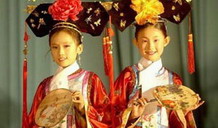China's 56 Ethnic Groups
Kazak: mainly dwell in Xinjiang, Gansu and Qinghai; love music and have many unique musical instruments such as Dongbula; believe in Islam
Kirgiz: most live in Xinjiang; adept at literature, music, sports and handicrafts; do animal husbandry; some of them believe in Islam and some believe in Tibetan Buddhism
Lahu: most are scattered around the Lancangjiang Lahu Autonomous County; believe in Mahayana; regard black as the most beautiful color
Li: mainly live in middle and southern part of Hainan Province; favorite corn, rice and sweet potatoes; depend on agriculture, breeding and handicrafts industries
Lisu: most live in Yunnan and Sichuan Provinces; mainly live on corn and buckwheat; created their own calendar composed of ten months divided by nature's change
Luoba: dwell at the foot of Himalayas, and make a living by doing agriculture and hunting; have unique food custom, and corn, rice and a kind of local grain are their staple foods
Man: originated from the Jurchen tribes; have a long history and brilliant culture; the creator of Jin and Qing Dynasties; has made great influence to Chinese history
Maonan: mainly distribute in Huanjiang County in Guangxi Province; live on agriculture and handicraft industry; rice and corn are their staple foods
Miao: has a relatively larger popular compared with other ethnic groups in China; skillful in handicrafts such as paper-cutting, embroidery, weaving, and jewelry casting
Monba: mainly distribute in Tibet and has a long history; their staple food are corn, rice and buckwheat; adept in weaving with vines and bamboo vines; have interesting wedding ceremony
Mongol: primarily live in Inner Mongolia; the minority on the horseback; the staple food is meat and milk; the greatest festival is Nadam Fair
Mulam: a smaller ethnic group dwelling mainly in Guangxi Province; believe in natural spirits; adept at pottery making and iron forging
Naxi: mainly live in Yunnan, Sichuan and Tibet; the major production activities are handicrafts, stock breeding and farming; most of them believe in Dongba Religion
Nu: most live in the southwest of Yunnan Province; believe everything has spirit and some believe in Christianity and Lamaism; good at playing musical instruments
Oroqen: dwell mainly in Inner Mongolia and Heilongjiang Province; good at hunting and making wares with iron, wood and bone; the staple food is meat
Primi: live on agriculture and livestock; believe life is influenced by gods and ancestors; celebrate Spring Festival, Pure Brightness Festival and Dragon Boat Festival
Qiang: mainly live in Aba Tibetan Autonomous Prefecture in Sichuan Province; their staple foods are beef, mutton, chicken, fish, corn, wheat and potatoes
Russ: derived from Russian immigrates in 18th Century; most live in Xinjiang Uygur Autonomous Region; celebrate Christmas Day and Easter Day
Salar: mainly live in Qinghai, Gansu and Xinjiang Provinces; make a living by engaging in horticulture, handicrafts and agriculture
She: most live in Fujian and Zhejiang Provinces; believe in the influence of ancestors and totems; the staple foods are corn, rice, beans and potatoes
Shui: mainly distribute in Guizhou Province; have their own language; good at stone-carving, paper-cuts, silver jewelry making and batik techniques
Tagik: have splendid culture and long history; live on agriculture and stock husbandry; believe in Islam and lay stress upon etiquette






